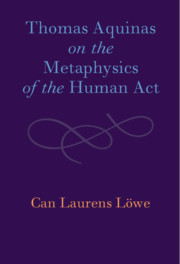Book contents
- Thomas Aquinas on the Metaphysics of the Human Act
- Thomas Aquinas on the Metaphysics of the Human Act
- Copyright page
- Dedication
- Contents
- Figures and Tables
- Acknowledgments
- Abbreviations
- Introduction
- Part I The General Framework
- Part II Choice Hylomorphism
- Part III Act Hylomorphism
- Chapter 6 The Hylomorphic Structure of the Human Act
- Chapter 7 The Ontology of Bodily Human Acts
- Chapter 8 The Ontology of Mental Human Acts
- Chapter 9 Aquinas’s Act Hylomorphism Today
- Appendix Judgment and Composition and Division
- Bibliography
- Index
Chapter 9 - Aquinas’s Act Hylomorphism Today
from Part III - Act Hylomorphism
Published online by Cambridge University Press: 25 June 2021
- Thomas Aquinas on the Metaphysics of the Human Act
- Thomas Aquinas on the Metaphysics of the Human Act
- Copyright page
- Dedication
- Contents
- Figures and Tables
- Acknowledgments
- Abbreviations
- Introduction
- Part I The General Framework
- Part II Choice Hylomorphism
- Part III Act Hylomorphism
- Chapter 6 The Hylomorphic Structure of the Human Act
- Chapter 7 The Ontology of Bodily Human Acts
- Chapter 8 The Ontology of Mental Human Acts
- Chapter 9 Aquinas’s Act Hylomorphism Today
- Appendix Judgment and Composition and Division
- Bibliography
- Index
Summary
This chapter assesses the merits of Aquinas’s hylomorphic account of the human act by comparing it to three contemporary action theories: (1) Donald Davidson’s causal theory of action, (2) Jennifer Hornsby’s agent-causal account, and (3) John Searle’s component analysis. It argues that Aquinas’s account has several advantages over these theories. First, it does not fall prey to the problem of deviant causal chains, which besets Davidson’s theory. Nor does it fall victim to the problem of the disappearing agent, which besets Davidson’s as well as Searle’s theory. Finally, Aquinas’s theory also has an advantage over Hornsby’s account. On Hornsby’s picture, a bodily human act is a causing that occurs inside the body, which has the counterintuitive consequence that human acts are unobservable, on her view. The chapter argues that for Aquinas only one component of a bodily human act is unobservable, namely, the volition, while the bodily commanded act is open to our gaze. Despite these advantages, it argues that Aquinas’s theory also has a drawback, namely, the dualism on which it is predicated. But it suggests that his hylomorphic theory of the human act can be detached from his dualism.
Keywords
- Type
- Chapter
- Information
- Thomas Aquinas on the Metaphysics of the Human Act , pp. 193 - 202Publisher: Cambridge University PressPrint publication year: 2021

